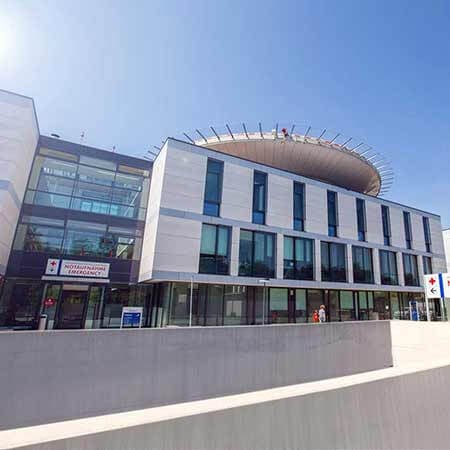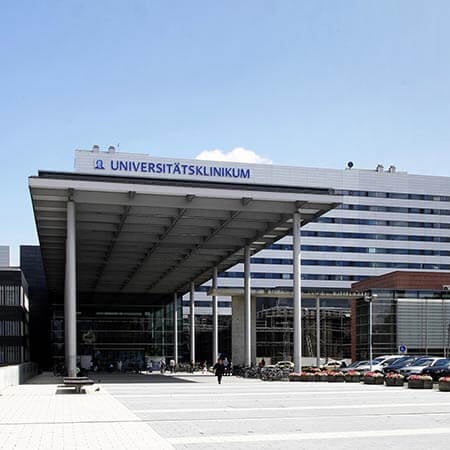Top Hospitals for Treatment of Lumbar Spinal Stenosis
Each hospital in this list meets Booking Health’s strict international standards: at least 250 surgeries per year, ISO‑certified quality management, and documented survival outcomes. Our medical board then ranks the clinics by clinical expertise, technology, and patient‑satisfaction scores.

The Beta Clinic Bonn is a modern private healthcare facility with 20 specialized departments. In addition, the clinic cooperates with 30 independent doctors of various specializations, most of whom have their own private practices. The doors of the clinic first opened for patients in 2008. Since that time, the medical facility h
Diagnostic tests for lumbar spinal stenosis
Price from:
0.00
Go to the program Treatment of lumbar spinal stenosis (1 segment) with decompressive laminectomy and discotomy
Price from:
13009.94
Go to the program Treatment of lumbar spinal stenosis (2-3 segments) with decompressive laminectomy and discotomy
Price from:
17014.58
Go to the program Treatment of lumbar spinal stenosis (4 segments) with decompressive laminectomy
Price from:
18528.38
Go to the program Surgical treatment of lumbar spinal stenosis in combination with instability with decompressive laminectomy and the stabilizing operation (4 segment)
Price from:
33741.31
Go to the program Treatment of lumbar spinal stenosis in combination with instability with decompressive laminectomy and the stabilizing operation (1 segment)
Price from:
26690.44
Go to the program Treatment of lumbar spinal stenosis in combination with instability with decompressive laminectomy and the stabilizing operation (2-3 segments)
Price from:
33479.27
Go to the program Treatment of lumbar spinal stenosis (1 segment) with decompressive laminectomy
Price from:
13965.2
Go to the program Treatment of lumbar spinal stenosis (4 segments) with decompressive laminectomy and discotomy
Price from:
18808.17
Go to the program 
The University Hospital Freiburg is famous for its rich history and is one of the oldest and most prestigious medical facilities in Germany (one of the three best medical institutions in the country). The hospital was based on the Faculty of Medicine of the Albert Ludwig University of Freiburg, which celebrated its 550th anniver
Diagnostic tests for lumbar spinal stenosis
Price from:
0.00
Go to the program Treatment of lumbar spinal stenosis (1 segment) with decompressive laminectomy and discotomy
Price from:
12698.83
Go to the program Treatment of lumbar spinal stenosis (2-3 segments) with decompressive laminectomy and discotomy
Price from:
17191.01
Go to the program Treatment of lumbar spinal stenosis (4 segments) with decompressive laminectomy
Price from:
18686.02
Go to the program Surgical treatment of lumbar spinal stenosis in combination with instability with decompressive laminectomy and the stabilizing operation (4 segment)
Price from:
33612.9
Go to the program Treatment of lumbar spinal stenosis in combination with instability with decompressive laminectomy and the stabilizing operation (1 segment)
Price from:
26753.08
Go to the program Treatment of lumbar spinal stenosis in combination with instability with decompressive laminectomy and the stabilizing operation (2-3 segments)
Price from:
33622.3
Go to the program Treatment of lumbar spinal stenosis (1 segment) with decompressive laminectomy
Price from:
13710.47
Go to the program Treatment of lumbar spinal stenosis (4 segments) with decompressive laminectomy and discotomy
Price from:
18813.39
Go to the program 
According to the reputable Focus magazine, the University Hospital Frankfurt am Main ranks among the top German medical facilities! The hospital was founded in 1914 and today is a well-known German medical facility, which combines rich traditions and scientific innovations. A medical team of more than 6,500 employees cares about









Diagnostic tests for lumbar spinal stenosis
Price from:
0.00
Go to the program Treatment of lumbar spinal stenosis (1 segment) with decompressive laminectomy and discotomy
Price from:
11470.04
Go to the program Treatment of lumbar spinal stenosis (2-3 segments) with decompressive laminectomy and discotomy
Price from:
15426.65
Go to the program Treatment of lumbar spinal stenosis (4 segments) with decompressive laminectomy
Price from:
16830.83
Go to the program Surgical treatment of lumbar spinal stenosis in combination with instability with decompressive laminectomy and the stabilizing operation (4 segment)
Price from:
29875.38
Go to the program Treatment of lumbar spinal stenosis in combination with instability with decompressive laminectomy and the stabilizing operation (1 segment)
Price from:
24228.69
Go to the program Treatment of lumbar spinal stenosis in combination with instability with decompressive laminectomy and the stabilizing operation (2-3 segments)
Price from:
30024.67
Go to the program Treatment of lumbar spinal stenosis (1 segment) with decompressive laminectomy
Price from:
12542.23
Go to the program Treatment of lumbar spinal stenosis (4 segments) with decompressive laminectomy and discotomy
Price from:
16618.9
Go to the program 

